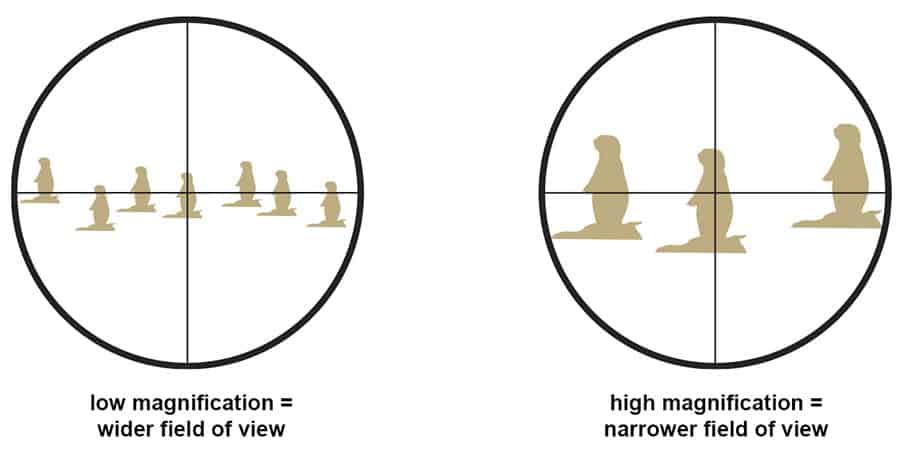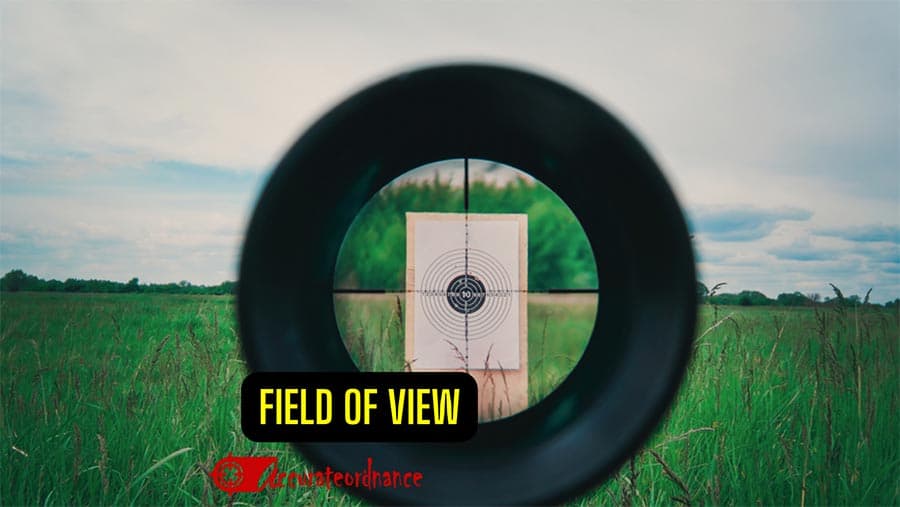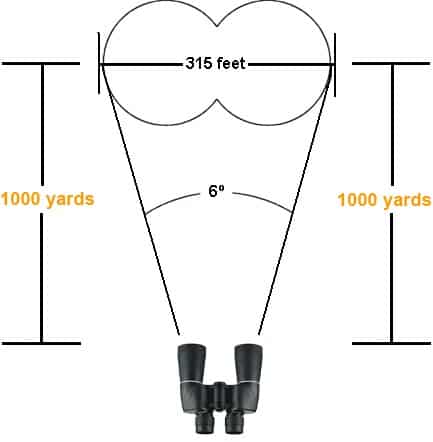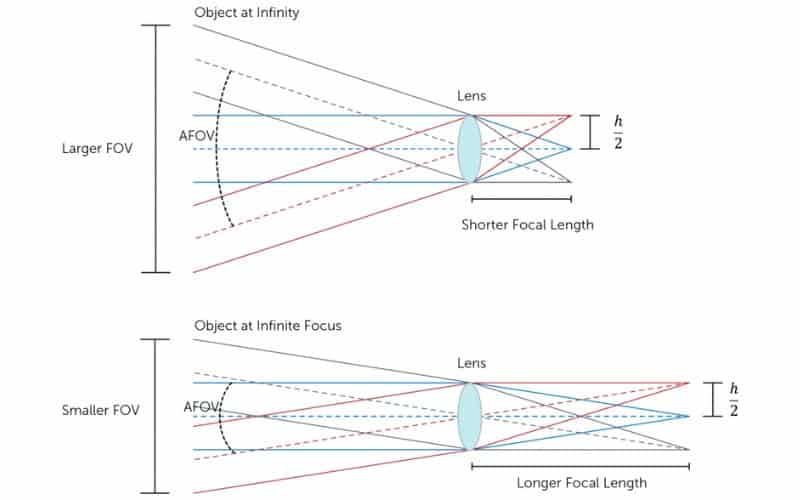
From the image above, you can see that the low magnification scope showed us more target animals, while the high power scope was only able to show a few.
What does Field of View Mean for a Rifle Scope?
The Field of View in a scope or any other optical device is the measurement of how much of a target can be seen at a particular distance. In simple terms, it is the size of the entire view from left to right that the shooter can see in the rifle scope when staring at it from a distance.

It is vital to take note that as the optical magnification increases, there would be a decrease in the field you can see. For example, when you are using a scope that has a 6x magnification, you can see everything around the target; however, when you use a rifle scope with a higher magnification, like a 24x power scope, your field of view is comparably reduced since you are more focused on your target rather than the area.
When selecting a rifle scope, make certain that it does not produce an effect called “tunneling,” which we would discuss now. So, what exactly is tunneling? Tunneling is a process in which looking through your scope feels like looking through a tunnel as the magnification increases. This can be detrimental to your aim and prevent you from getting a clear view or shot at far targets. That is why you must do your homework to choose a riflescope that does not produce a tunneling effect when zooming in on an object.
Is the Field of View of a Scope Only Measured at 100 Yards?
As previously stated, the field of view is the visible area when you look through a scope from 100 yards away. It is always measured in feet. The field of view in rifle scopes is usually meassured at 100 yards. While the FOV of other optical devices like rangefinders have a farther measuring distance which is at 1000 yards.

The FOV in a scope is often determined by the scope’s magnification setting. Whenever you use a high magnification on your scope, you will have a smaller field of view. A scope’s field of view can be affected by a number of factors. For example, you may have two identical scopes with different fields of view. This is usually a result of the curvature and form of the glass used in the scope.
When selecting a rifle scope, go for a manufacturer and model that offers a wider field of view, even at greater magnification. Aside from that, you’ll want to ensure that your riflescope has a consistent field of view proportional to the scope’s magnification level. For instance, if your FOV at 1x magnification is 120 feet, then you should expect to have 1/4 of that view when you increase the magnification to 4x.
Do You Need a Small or Large FOV For Your Shooting?
All shooters have different shooting needs and shoot at different ranges. As a result, it would not be wise to just conclude that a smaller or larger FOV is needed. Most hunters shoot their game animals at distances ranging from 50 to 150 yards. With this kind of shooting distance, a higher magnification is not necessary. Since you do not need a higher magnification for this kind of shooting, you might also need a smaller FOV.
When your target animal is closer to you, you need to have a broader view since the slightest move by the animal can make it go out of view if you’re using a smaller FOV scope.
What you need for hunting or mostly short-range shooting is a wider FOV. Also, apart from a broader FOV, you would need long eye relief. A broader field of view lets you aim more precisely at your target. If you want to shoot at a dangerous animal at a range between 50 and 150 yards, the recommended minimum magnification is 1x, and it is advised that you do not exceed a maximum magnification of 2.5x.
Increasing the magnification further will affect how much of the area you can see. Note that while hunting, you don’t just want to see only your target, you need to also see some areas around your target for the best shot.
What Determines FOV in a Scope?
A scope’s field of view is usually determined by the magnification of the scope and the focal length of the eyepiece.
Since all scopes have different levels of magnification, the field of view will also vary depending on the scope manufacturer.
When selecting a rifle scope, keep in mind that the objective lens diameter of your scope cannot be used as a determinant factor for the field of view. The objective lens diameter will only improve light transmission. If you are working with a large field of view, you will need a high-quality lens system to produce a clear and crisp target image.
Does Magnification impact FOV?
Magnification refers to how near you can perceive a thing from a distance in comparison to what is apparent to your naked eye. It would be difficult to see a far target if you do not use a scope with some amount of magnification. By looking through a scope your target appears clearer and closer.
This makes magnification a very important factor when searching for a scope that will allow you to shoot at objects that are further away. As a beginner, you should be aware that magnification can only help you get closer to your target and nothing more, so you have to use the right amount.
In other words, greater magnification does not imply greater accuracy. How does one determine the best magnification range for a riflescope based on their circumstances?
Keep in mind that as you increase the magnification of your scope, the FOV decreases, and as the magnification decreases, the FOV increases.
A 3x variable magnification scope has a FOV of little more than 30 feet at 100 yards, while a 9x magnification scope has a FOV of roughly 14 feet. You can see that the FOV reduced as the magnification increased.

It should always be emphasized that a bigger objective lens diameter does not have an impact on these figures.
How to calculate Field of View
Optics Manufacturers provide a variety of field-of-view measures. The FOV of rangefinders, spotting scopes, and binoculars is commonly measured in feet at 1000 yards. In comparison, the FOV of a scope is measured in feet per 100 yards.
Binoculars with a FOV of 341 feet at 1000 yards give a viewpoint that is 341 feet wide from the left view to the right view when the distance viewed is 1000 yards. When distance is measured in meters, yards, or feet, they are referred to as a “linear field of view.”
In some cases, the FOV can be measured in angular degrees. For instance, we can say that a rangefinder has an angular FOV of 6.0 degrees.
The angular field does not change based on the distance of the target, unlike the linear FOV that increases or decreases based on how far the target is. Angular FOV can be converted easily to linear FOV. All you just have to do is to multiply the angle by 52.5 to get the linear field of vision in feet.
For example, to calculate the distance of a rangefinder with a FOV of 6.0 degrees at 1000 yards, you will multiply degrees (6.0) by 52.5 feet, and you would get a linear FOV of 315 feet. This is due to the fact that 52.5 feet equal one degree of angle.

Mike Hardesty is a published freelance gun writer. He also possesses specialized expertise in rifle scopes With dozens of articles and reviews published in Pew Pew Tactical, Snipercountry.com, and TTAG (The Truth About Guns), Mike is considered a firearms expert. His special area of expertise is handguns.
Mike is a long-time shooter. He has been punching paper targets, taking deer and other game and shooting at competitions since about 1975. Other related pursuits include reloading and bullet casting. He currently reloads for over 10 calibers, both handgun and rifle. His reloads, particularly for 9mm, were in great demand during the height of the ammo shortage among family and friends. He donated hundreds of rounds to informal shooting sessions. He was quoted as saying “I do not sell my reloads but I sure will help my guys shoot ’em for free!”. He has a few cherished firearms that he has inherited or otherwise procured — those are his favorites.
He earned B.S. and M.S. degrees from Indiana State University in 1974-1975.
He’s a firearm experts and is the founder of mhardesty.com.

Please explain this field of view, it’s for a thermal scope.
Field of View: 12.5 x 10.0°
Hi Clay,
In this case the FOV is 12.5 degrees horizontally and 10.0 degrees vertically. This means that when you look through the scope, you will see a rectangular area that is 12.5 degrees wide and 10.0 degrees tall.
Hope it help.
So how much field of view is 1.1 degrees to 5.8 degrees?
The linear FOV for the given angular FOV range of 5.8 – 1.1 degrees at 100 yards is approximately 10.5 feet to 1.9 feet. Meaning an area of 10.5 feet can be seen at the lowest magnification and 1.9 feet at the highest.